[adinserter block=”1″]
Although they share a lot of the same core specifications and features, there are some important differences between the mid-range XT50 that was released in 2024 and the flagship XT5 from 2023.
So we’re bringing you this in-depth Fujifilm X-T50 vs X-T5 head-to-head comparison to help you choose between these two mirrorless cameras.
You can also read our detailed Fujifilm X-T50 review and Fujifilm X-T5 review to find out exactly what we think of each camera.
Sensor
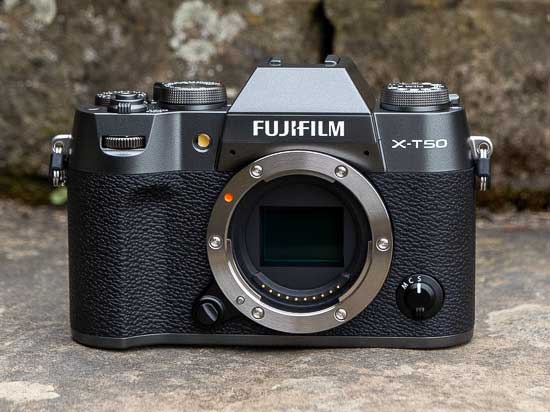
The image sensor used in the new X-T50 is exactly the same as the one found in the X-T5.
They both have a 40.2 megapixel X-Trans CMOS 5 HR sensor, with HR standing for High Resolution.
This is a BSI (back-side illuminated) sensor design that has more of a focus on detail and resolution than out-and-out speed.
It also allows both the XT50 and XT5 to record 6K video, surpassing previous generation models which could only record up to 4K video.
They also share the same X-Processor 5 image processor, so both models will therefore provide exactly the same image quality as each other.
Pixel Shift Multi-shot
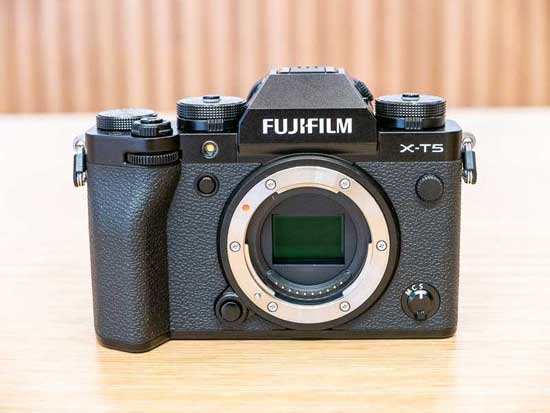
The X-T5 became the first ever X-T series Fuji camera to feature the special Pixel Shift Multi-Shot mode when it was released in 2023, which delivers 160 megapixel images for the ultimate quality when detail really matters.
Previously only seen on the company’s GFX-branded medium-format cameras, in the Pixel Shift Multi-Shot mode the camera records 20 frames, shifting the sensor by 0.5 pixels between each frame.
The resulting images are automatically combined into one DNG RAW file, which can then be output to a desired file format using suitable RAW processing software.
Sadly, despite having the same image sensor and processor, the new X-T50 does not offer this feature at all.
ISO Speed
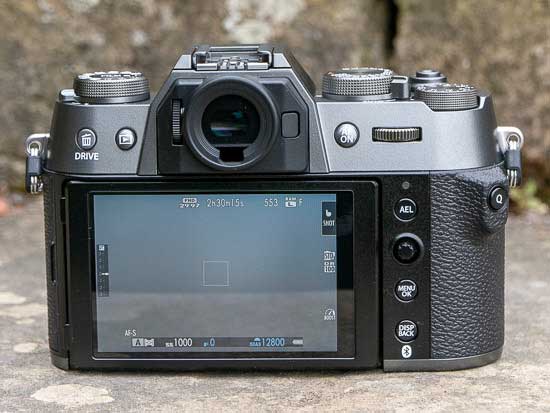
The new X-T50 and the X-T5 both have a base sensitivity of ISO 125, which can be expanded down to ISO 64 and up to ISO 51,200.
Video

The X-T50 offers the same video features and performance as the X-T5 – both are equally good choices if you have any interest in movie-making.
They offer a highest video quality rate of 6.2K/30p with a modest 1.23x crop, recorded in 4:2:2 10-bit internally.
Both cameras also support up to DCI 4K/60p recording without applying any crop, and both can shoot 1080/240p slow-motion footage.
They offer the latest F-Log 2 profile with up to 14+ stops of dynamic range.
Combined with a compatible HDMI recording device from Atomos or Blackmagic Design, 12-bit RAW video output can be recorded as Apple ProRes RAW or Blackmagic RAW.
They have a digital zoom function that uses the camera’s 40.2MP sensor to deliver up to 2x of digital zoom with little to no loss in resolution when recording video in 4K.
Autofocus
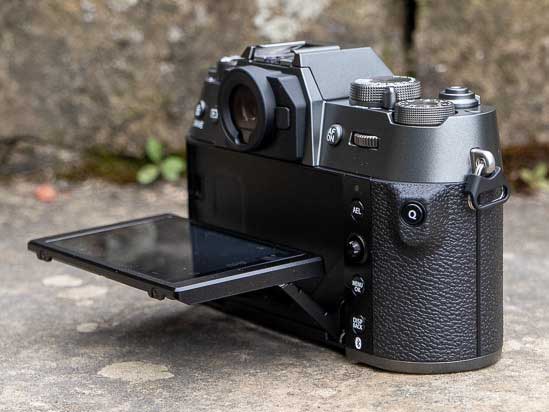
The new X-T50 has exactly the same hybrid autofocus system with phase detection and and contrast detections points as the more expensive X-T5.
In the Single point AF mode there are up to 425 selectable AF points arranged in a 25×17 grid. Alternatively, the camera can be set to 117 points in a 13×9 grid, and the size of the points can also be varied.
In addition to Single point AF, there’s Zone AF which allows the AF points to be selected in 3×3, 5×5 or 7×7 groups, and Wide/Tracking AF.
Both cameras can automatically detect animals, birds, cars, bikes, planes and trains thanks to the X-Processor 5’s AI deep learning capabilities.
Thanks to the 40 megapixel sensor, they also offers a large number of PDAF points (3.3 million).
Both cameras can focus down to an incredible -7EV in low-light.
Burst Shooting
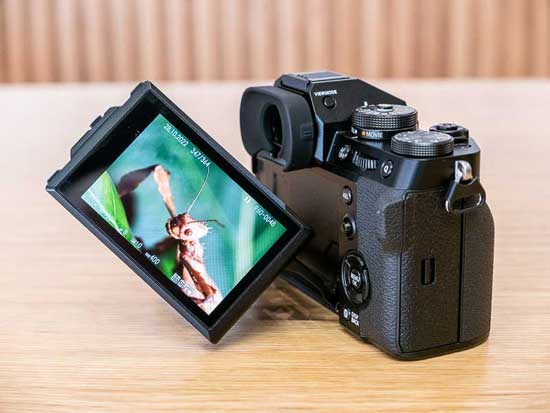
Both models can shoot at up to 20fps when using the electronic shutter, with a 1.29x crop applied.
There is one key difference though. While the X-T5 provides 15fps continuous shooting speed when using the mechanical shutter, the X-T50 is limited to just 5fps.
It does have a much larger buffer though when using the mechanical shutter – 1000+ JPEG or compressed RAW frames versus 119 on the X-T5.
Shutter Speed
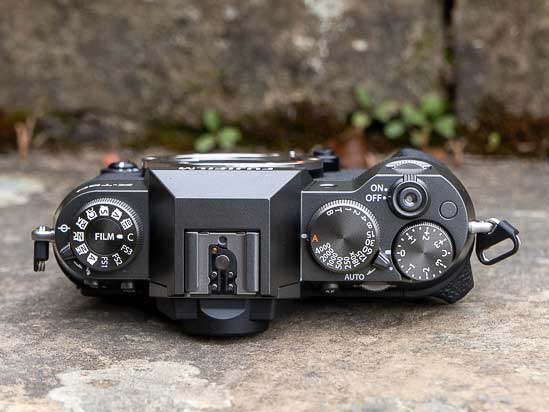
Both cameras offer an impressive fastest shutter speed of 1/180000 sec for the electronic shutter.
This allows users to leave the aperture wide open in very bright conditions such as a sunny beach or a ski slope, or to capture a split-second motion.
Body and Design
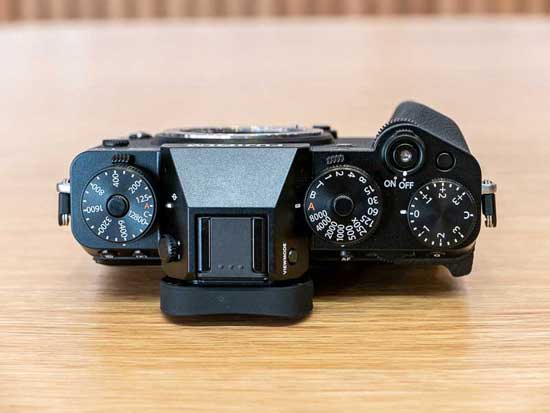
The X-T5 implements all of the traditional dials and controls that Fuji users have come to know and love, including the classic Fujifilm ISO, Shutter Speed and Exposure Compensation dials on top of the camera.
The X-T50 take a similar approach with three dials on the top-plate, but one of them is the brand new dedicated Film Simulation dial which replaces the drive mode dial. This is a first for the X-T series, providing quick access to selected simulations plus three user selectable modes.
Featuring a new rounded design, the X-T50 is significantly smaller and lighter than the flagship X-T5.
The XT5 weighs 476g body only or 557g with a battery and memory card fitted.
The XT50 weighs 389g body only or 438g with a battery and memory card fitted.
IBIS

IBIS is included for the first time on an X-Txx series camera, so both the X-T50 and X-T5 feature 5-axis in-body image stabilisation (IBIS) that delivers up to 7 stops of in-body image stabilisation.
Viewfinder
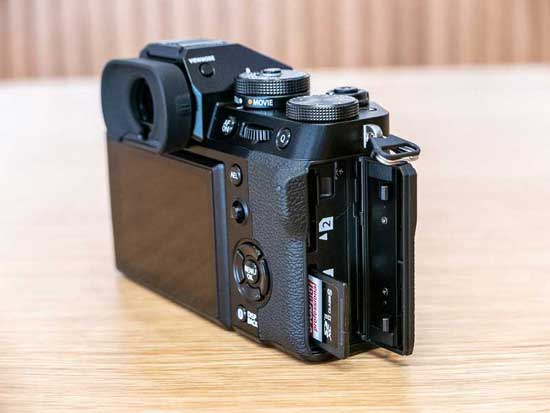
The X-T5 has a very good 3.68M-dot OLED electronic viewfinder with 0.80x magnification, 100fps refresh rate and a built-in eye sensor.
The EVF on the XT50 is slightly inferior, with 2.36M-dot resolution, 0.62x magnification, 100fps refresh rate and a built-in eye sensor.
LCD Screen

One of the biggest differences between these two cameras is the action of the LCD screen.
Fujifilm implemented a 3-way tilting LCD on the X-T5, saying that it better matched its more stills-focused nature.
The screen on the new X-T50 has an even simpler 2-way tilting design which makes it less versatile, especially for video use.
The resolution of the screen on both cameras is 1.84M-dots, making it the highest-res screen of any current Fujifilm APS-C camera.
Memory Cards
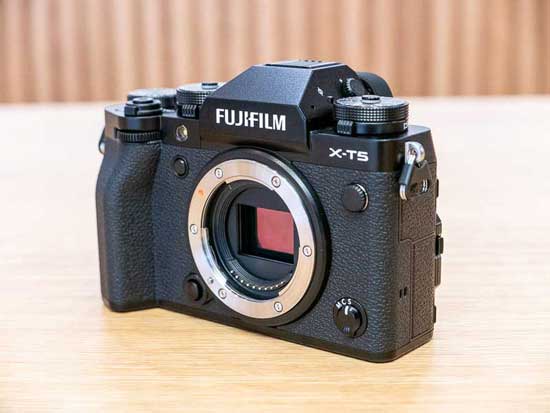
The X-T5 has dual memory card slots, utilising two UHS-II SD card slots housed in a dedicated compartment on the side of the body.
The smaller X-T50 only has a single UHS-II SD card slot that’s located on the bottom of the camera inside the battery compartment.
Battery Life

The X-T5 uses the larger-capacity NP-W235 battery, which provides up to 740 shot battery life in economy mode.
The X-T50 uses the smaller-capacity NP-W126S battery, which only provides up to 390 shot battery life in economy mode.
Both cameras can also be powered and charged via a USB-C connection, which is useful if you’re out and about and have a compatible power-bank to plug the camera into.
Battery Grip
Perhaps somewhat controversially, both the new X-T50 and the X-T5 do not support a vertical battery grip (there are no contacts on the bottom of either camera).
Fujifilm say this is based on market data for the previous models which showed that the majority of owners did not buy one.
Instead you can buy the optional MHG-XT5 metal hand grip if you feel than the body on its own is too small, but this only applies to the X-T5, as no hand grip has been released for the X-T50.
Price
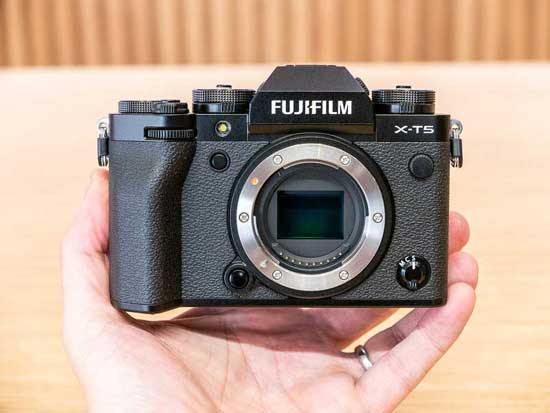
The Fujifilm X-T5 is priced at £1699 / $1799 body-only in the UK and USA respectively.
The newer Fujifilm X-T50 is priced at £1299 / $1399 body only.
Conclusion
The new Fujifilm X-T50 uses exactly the same 5th generation 40-megapixel sensor and image processor as the X-T5, so it essentially provides the same stills, video and auto-focus performance – you’d really be hard-pressed to tell the differences, if any, between them.
Offering a similar classic retro styling and control layout to the X-T5, the X-T50 is also both smaller and lighter and has the handy new Film Simulation dial, whilst costing some £400 / $400 less than its big brother.
On the flip-side, the X-T50’s LCD screen has more limited 2-axis movement, the electronic viewfinder is lower in both resolution and magnification, there’s no 160mp Pixel Shift Multi-Shot mode, continuous shooting is much slower when using the mechanical shutter, the battery life is much smaller, there’s only one memory card slot housed more inconveniently in the battery compartment, and no optional hand-grip at all.
So what do you think? Would you choose the new X-T50 or the flagship X-T5? Leave a comment below!
Your Comments
[adinserter block=”1″]
Credit : Source Post

